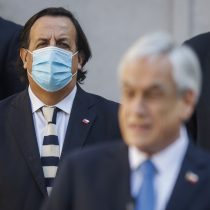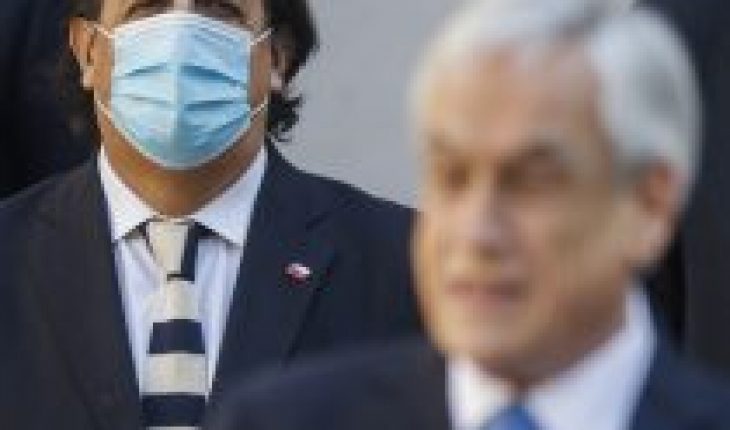
If anything has characterized the interpretation of the last days about the change of cabinet made by Sebastián Piñera, it is a tendency to reduce it in its political reach. This is not consistent with the efficiency of such action. The immediate criticism from the opposition is still installed on the Rechazo-Apruebo scale in the constituent plebiscite. Even some of the most shrewd opposition analysts, such as Ernesto Aguila, tend to raise the reasonable hypothesis of closure, a right-to-right retraction to itself: bunkerization.
I believe that this interpretation is not wrong to interpret the subject from the plebiscite, but by its reading in the way that the political right understands it. Contrary to what you’re proposing, I think the right is not locking up, it’s not parapeting, it’s not in a war of positions, but in a strategy like a crusade. And 10% “defeat” is the best example of this. Well, almost all of the opposition, plus some right-wing parliamentarians, won a tactical triumph over the more radical defense of the dictatorship’s pension system, but at the price of giving the system a strategic advantage and its ideological foundation: the defense of funds as an individual property expressed for an immediate and real economic benefit, the withdrawal of “my” money.
After the defeat of the Government, the strategy of defending the principles it represented and represents the dictatorship advanced several squares towards the goal of defending the individual over the community, of property above solidarity and did so underpinned by money counting and ringing.
That’s the thing about a crusade. Destroy the infidel into battle, force him out, expel him when he is already subdued, investigate and control even the most everyday aspects of his life to ensure that he sticks to dogma or eliminate him if at some point he becomes religion in a spurious way. It’s Clausewitz’s absolute war ideal. The big difference between war as a continuation of politics and it as a continuation of religion is precisely on that limit that dissolves the difference between an enemy with whom values and cultures are shared, and the savage, the barbarian, the absolute enemy to which only fully subdued or totally destroyed. Crusades are religious-military actions, not political ones. Hence its success in principle and also its total breakdown.
The strange path chosen by the Government on 18 October 2019 is entering its maturation stage, less than three months after the realization of the constituent plebiscite. What initially seemed to represent an opportunity for Sebastián Piñera (because he was not obliged by the circumstances to act in a specific way and, rather, had a second opportunity to position his Government with the arrival of COVID-19) he finished sealing the possibility of expanding his field of political influence. With the hardening of the line and faces, as well as the disappearance of the minimal gender component, the rear of the government (built with the auxiliary troops of Christian Democracy, mainly), becomes too clear if it remains part of a program with that level of conservatism and authoritarianism.
It is one thing to pass repressive laws with Blumel and, another, to do so in embrace with Jacqueline Van Rysselberghe’s circle of trust. Inadvertently, the strategy used forces moderate forces (allegedly in opposition) to define themselves in the midst of the Pinochetist crusade, which augurs a difficult legislative and political path for the Piñera government.
The racist attack on mapuche communes and comuneros taking from the municipalities between the night of August 1 and early morning was the initial kick-off of a path that leads to the defeat of the Rejection option, as well as a long stint in hell for the government, but which allows him to engender great hopes for the strategic outcome , that is, the construction of a block, which is what is behind a Constitution.
The option is to go out and give all the battles, even though they are known to be lost, because the political articulation that generated the popular uprising of October 18 changed the correlation of forces. For the right, however, they are defeats with their own weapons. They are not victories with other people’s weapons, as it was 10%, which although it is a success in the short term, is a setback in the long run. We already know the importance of these defeats, as the martyrs show.
As I pointed out before, the tactic is not to lock yourself in, but to go out, to act, fight, fight the street with ideas of their own. This formula proved tremendously successful for European far-rights in the course of World War I.
It is still symptomatic that Victor Pérez, the new Minister of the Interior, has been (and apparently is to this day) an exacerbated defender of Colonia Dignidad, going on to march flanking Paul Schofer. That a person with ties to the paramilitary sect of Schsfer comes to the second-highest office of the Executive Branch is worrying, given the way in which European far-right groups came to seize power in Germany and Italy.
The link between the police and the German army with the right-wing militias is known, prior to Hitler’s rise to the Chancellery. On 15 January 1919, far-right militias led by Ernst Ruhm supported the police and military repression of the Revolution that had erupted in Berlin. This same Ruhm would go on to form the S.A., (Sturmab-Abteilung) the dreaded Nazi brown shirts, the paramilitary shock forces that would take control of the street until it ended up integrated into the army and the police. This alliance involved repressive capacity, protection and development of shock groups under the institutional order.
The same drive path between far-right groups and the police and army occurred in Italy, prior to the arrival of fascism in the government. The black shirts (Milizia Volontaria per la Sicurezza Nazionale) would also end up integrated as an army unit in 1923. The protection by the police of these fascist shock groups, while applying a heavy hand against left-wing groups, allowed them to use fear and terror as formulas to combat their enemies, while gaining police and military sympathies.
The tactic combines three aspects: the signaling of a clear and particularly repugnant enemy to the military and police mentality because of its opposition to patriotic values and order; the creation of shock militias made up of ex-militaries and policemen, who appear to be carrying out the actions that the police for legal and institutional circuits cannot do; the complicity of the high commanders with the ideas of these shock groups, the underground linkage of active members of the police and military forces with the far-right shock forces and the development of an ideology of homeland salvation. In our country the use of this tactic, we were able to observe it in the incorporation of members of Homeland and Freedom in actions of repression and extermination after the coup d’éte. Also, Colonia Dignidad itself was part of this direct relationship between the repressive apparatus of the dictatorship and paramilitary groups.
This strategy that combines repression, street confrontation, increased crime and criminal violence, in contexts of high social mobilization and institutional crisis, needs the paramilitary component. It is part of the ideological installation of the longing of previous normality and tranquility.
In the attack on the Mapuche communes at the beginning of August, the speech was clear: they are ordinary people who were bored of being kidnapped by the violence of minor sectors within the Mapuche people. Of course, this speech little matches the policy of extermination that was used since the beginning of the dictatorship against the Mapuche people and which was articulated with an important part of civilians who belonged to far-right groups. The Mapuche macrozone was a place where the violence of the dictatorship was particularly extreme. This contributed to the development of the guerrillas in Neltume and the land recoveries developed by the MIR during the People’s Unity, which exacerbated the inchin of the regional aristocracy, deeply racist since the beginning of the Republic.
If we take into account that all this I point out is given within the framework of the constitutional plebiscite, it is possible to understand the optimism that the strategy that is being developed produces on the right. However abysmal the defeat of the Rejection, having to move to the development of a staff of candidates who integrate the constituent convention, the disintegration, the archipelago (in the words of Ernesto Aguila) representing the “left” and “opposition” positions, tend to lose electoral capacity.
In this context, regional caudillisms, the chain of political operators on the ground, the parting unit and the increased public visibility, give an absolute advantage to a program with few points of unity with the expectations that appeared with greater emphasis since the popular uprising in October. For example, it is almost unthinkable that an alliance that will come togetheror the end of AFPs with a State that guarantees education, taking responsibility for it and not just fulfilling a subsidiary role.
Although at the first point it is possible that a part of Christian Democracy may agree, however, the links between this party and various Catholic supporters, they make it very difficult for them to participate in an agreement that changes the principle of educational freedom over the right to education, which have been at over strain since the beginning of public education in Chile. The right has in your favor that the program you will defend is the existing one. Part with an agreement, you don’t have to get to it.
The skilled Pablo Longueira expressed this by saying that he had to skip the plebiscite and move directly to the choice of convention. Although the idea was interesting, of course, it didn’t have much support. However, it expresses very well the confidence and tranquility that delivers the change and the cabinet redness. There is no better way to control those who oppose us than by having them close, as Louis XIV made it clear when building Versailles. In addition, the main ministry returned to the UDI hard line. And finally, a scenario of high social conflict is perfect for a strategy that sees the political and the military as a single component, as it allows it to expand its support base, ideologically infiltrating the police and military forces.
This combination of formulas, while involving losing a portion of the government’s forces during Blumel’s cabinet (which augurs a difficult legislative scenario), is excellent for going out and facing the forces that were activated and are in the process of organizing since October last year. Already several parliamentarians of the Party for Democracy (PPD), the Radical Party, the already named Christian Democracy and even the Socialist Party have been available to support Piñera’s repressive agenda.
While they may be more wary of doing so with a protector from Colonia Dignidad, we cannot expect support for the transformative agenda that social mobilization installed. Although the government will have more difficulty negotiating a common agenda with them and the interests they represent within their parties, they are strong enough to set up people from their constituent group or ranks at the constituent convention.
Enough to bring about, in conjunction with the right, changes to the constitutional and institutional system that do not profoundly alter the status quo arising from transitional agreements and neoliberal principles in the management of the broadest aspects of life. In their favor, several million Chileans will have enjoyed the economic freedom that underpins the existence of afNPs. A new Constitution with the same ideas, but legitimized by a plebiscite.
However, this strategy followed by the right carries a high risk. On two occasions during the twentieth century she acted in a similar way and ended up totally defeated and forced to articulate in a new way.
The first was after Gustavo Ross’s defeat to Pedro Aguirre Cerda, from which Christian Democracy was born and would eventually lead irrelevance to the Liberal-Conservative party. The second would occur in 1964, when the right would leave Julio Durán’s campaign to support Eduardo Frei and thus prevent Allende from becoming President. After this debacle the right would re-assemble in the National Party.
Both defeats of the right led to an acceleration of social mobilization and the consolidation of a reformist strategy for the benefit of the popular classes. The cross strategy that seeks to deploy the right has already failed on other occasions, however, this has not prevented it from using it again or maintaining it in time. The danger is worth it, for even with moments of defeat, the formula allowed him to take political and military control at times of greater institutional disorder, something similar to what happens today. Just as things stand today, expectations have a high chance of compliance, considering that in the face of a clear, hard and ruthless strategy, a multiplicity of perspectives without unity or hegemony, is extremely inoperative.
The mistake of this strategy and what allows us to engender hopes for a democratic institutional exit to the current political crisis is that we may not be faced with a war of movements, capable of winning with constant risky tactical actions, but in the context of a deepening of civil society (similar to an explosion) following the popular uprising in October.
Confinement and quarantine that in the upper classes (bourgeoisie, alt administratorsor level as managers or other positions, professional groups, among others) has been lived as a bubble; in the popular classes, where poverty, unemployment, hunger and debt are the scouring, have involved the breaking of the bubble and the tendency to meet and organize. Common pots and popular self-help formulas have not only been assistive mechanisms, but also experiences of organization, articulation and development of classist political consciousness. The organization carries order and this produces trust and security.
Perhaps we are witnessing the germ of a new hybrid civil society between territoriality and new virtuality. If this is the case, the current institutional political system will not live up to it and new forms of governance and exercise of power and authority will need to be thought of. The flag of true democratization is always popular. This may be the point of sustenment not to fight for a new Constitution only, but to fill it with content and ideas that are the basis of an alternative popular agenda to which the ossified institutional apparatus of traditional opposition parties will defend.
As Sun Tzu (Sunzi) teaches in the Art of War, the greatest victories are the ones that are achieved without having to use the weapons. those are earned in the minds of those in combat, so they are inversely proportional to the crusades.
The content poured into this opinion column is the sole responsibility of its author, and does not necessarily reflect the editorial line or position of El Mostrador.





